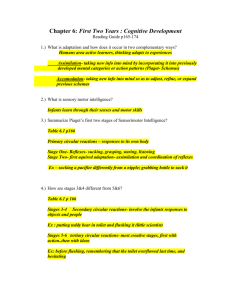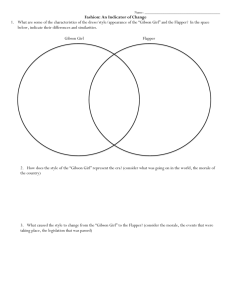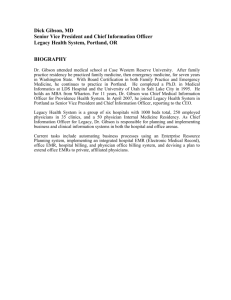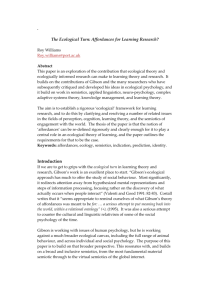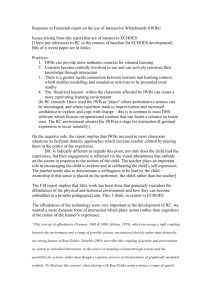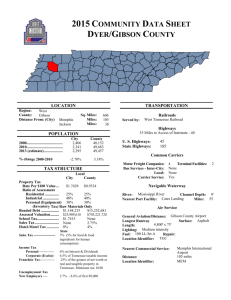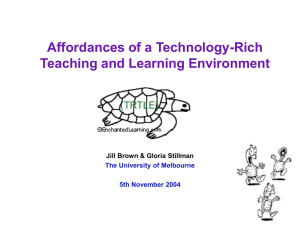S04_1200 Sofie Pedersen - ISCAR 2014 Presentations
advertisement
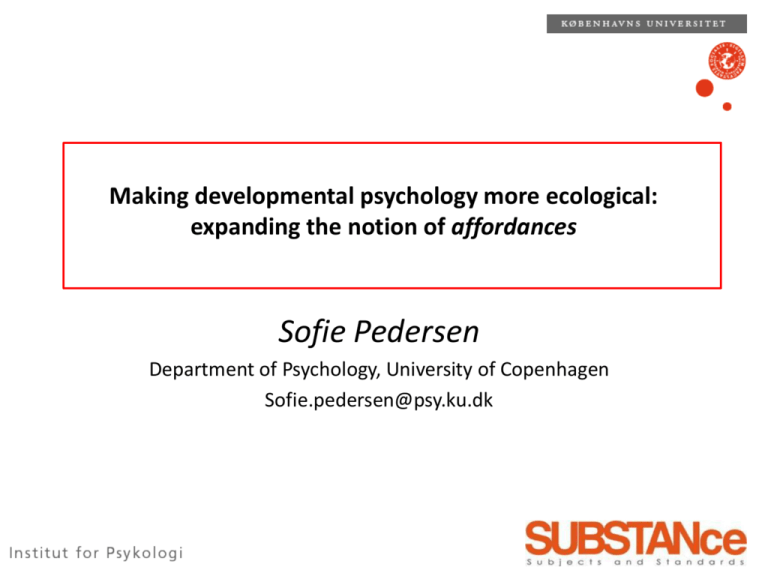
Making developmental psychology more ecological: expanding the notion of affordances Sofie Pedersen Department of Psychology, University of Copenhagen Sofie.pedersen@psy.ku.dk Why this endeavor? • Focus: how youth determine who they are and how they ought to be; what directs them and shapes their self understanding? • Youth as a particular transition period with certain abstract-universal developmental features. Theories of youth development have a tendency to either employ a sociological gaze or a very individualistic, in terms of biological maturation. • Tendency towards categorization: Youths as a generalized, decontextualized group under the headlines of identity crisis, reckless or irresponsible behaviour, oppositional behaviour, raging hormones, laziness, large alcohol consumption… • From following 6 youths (age 15/16) throughout their first year at high school, I acquired an increased interest in the invitational character of the environment; how does the environment invite you to be or become – how do certain standards (of youth) come into play and acquire meaning and how are subjectivities created and unfolded? Gibson’s notion of affordances • Describing himself as a behaviorist, Gibson embraced the goal of establishing predictable functional relations between environmental conditions and behavior. • By the 1950s Gibson abandon the scheme of stimulus-response thinking and realize that humans (and animals) come to know their environment through their activities and movements through time and space. These movements were in themselves a necessity in order to gain access to the relevant informative structures – the affordances - that support perception. As such, this marks an expansion of the perceptual understanding; what we attend to in surroundings are not merely shapes, colors and layouts, but “rather the meaning of things for action” (Costall 1995:470). • Inspiration from gestalt tradition, Koffka and Lewin: ‘Aufforderungscharacter’ (or valence) – the idea that things have meaning in themselves. Eventually Gibson parted with this notion (a qualitative shift)and developed his notion of affordances: affordances set themselves apart in that the affordance does not change according to the need of the perceiver. The affordance is invariant and thus exists regardless of the perceiver’s intentionality (Gibson 1986). • “The affordances of the environment are what it offers the animal, what it provides or furnishes, either for good or ill. The verb to afford is found in the dictionary, but the noun affordance is not. I have made it up. I mean by it something that refers to both the environment and the animal in a way that no existing term does. It implies the complementarity of the animal and the environment.” (Gibson 1986, p. 127) Problems with Gibson’s theory The undifferentiated notion of activity: (see also Bærentsen & Trettvik 2002) In Gibson’s account of affordances, his focus is on the ‘fit’ between the perceiver and the environment, and his examples mostly point to functional aspects, such as graspable, cut-able etc., thus mostly relating to functional or partial aspects of human life. This implies that his account of activity is mostly understood on an operational level. However, even though affordances are described by Gibson as existing independently of the observer (as potentialities of the environment), “these objective features only become affordances when some organisms relate to them in their activity. Affordances are therefore features of “activity systems” that include both the physical environment and the organismic prerequisites of phylogenetic origin that is genetically transmitted from generation to generation as species-specific adaptations to existing ecological niches. In the case of humans, affordances are also provided by external objects – e.g. tools – that are designed for use in specific forms of societal praxis.”(Bærentsen & Trettvik 2002:54). Problems with Gibson’s theory The undifferentiated notion of activity is in accordance with Gibson’s inability to : 1) account for the societal aspect of human life and 2) to transcend the immediate. In an immediate world – if I could freeze time for a moment – the cup on the desk in front of me affords drinking, because of its combination of properties, such as being grasp-able and pour-into-able. But if I did not know that the dark brown liquid in it was indeed coffee (that I like and am rather addicted to), this brown substance would probably not afford drinking. This can only be understood through the knowledge I have of myself as an actor (and user of coffee), built up through my participation in societal life (that also makes coffee available and has introduced me to its taste and caffeine advantages). An important notion that Leontjev repeatedly returns to, is the fact that “it (activity) cannot be regarded as something extracted from social relations, from the life of society. Despite all its diversity, all its special features the activity of the human individual is a system that obeys the system of relations of society. Outside these relations human activity does not exist” (Leontjev 1977:182). Problems with Gibson’s theory The problem of immediacy: Gibson’s explanation of affordances assumes a world ‘that is already there’ and he thus assumes a world that is primarily material and immediate. Gibson does not account for the inherently social and historical nature of the world, and casts aside all that is cultural as second hand perception. He speaks of other humans as strong sources of affordances but neglects to account for how. Similarly he refers to artifacts in the world, but fails to account for their inbuilt intentions and historical construction. This is where Leontjev instated ‘activity’ as the connecting mediating ‘point’ in between individual and environment, however as a reciprocal process, not a unidirectional and causal. From a cultural historical point of view I would argue that this makes little sense and that what Gibson proposes as immediate is already and at the same time mediate. Problems with Gibson’s theory Where psychology begins Gibson seem to suggest that psychology starts with perception. However, he struggles with conceiving the processes of stability and change - and therefore it is difficult for him to grasp development. Rather, psychology begins with the mere principle of life, that of Autokinesis (Engelsted 1983): the psychic as a fundamental reference to the future – to future situations and goals. Based on the fundamental idea of need, motive and activity as a central developmental figure in cultural-historical psychology, Engelsted explains how the primary kind of activity must be a behavioral relating to the world (autokinesis) rather than a behavioral responding to the world (servo-kinesis). Summing up, a way for Gibson’s theory to approach human life is to take the ecological environment as a developmental one: 1. 2. Introducing affordances: that values and meaning are being re-placed in the organism-environment mutuality rather than being put into the mind; hence avoiding representationalism. The next important step is to take developmental change (history; genesis) seriously. This implies that not perception but (rather) autokinesis is where psychology beings. It further implies a developmental approach to affordances (rather than a static one). Practice affording: A possible synthesis? (Pedersen & Bang, XXXX) To account for this we would suggest the term ‘Practice Affording’ as a continued development of the notion of affordances. • Practice: as a way to integrate both ecological, historical and societal aspects of the human life world – Individuals cannot be understood isolated from the human practices in which they come to exist (and at the same time practices are created and recreated by individuals). • From ‘Affordance’ to ‘Affording’: “Affordances are not simply discovered, but nor are they mentally projected upon inherently meaningless things. They are negotiated”(Costall & Richards 2013:91). Stressing an active stance for the individual – meanings are negotiated and created and always evolving. In turn ‘practice affording’ encompasses the historical and societal nature of human life that transcends the immediacy of a given situation and connects the phylo-, socioand ontogenetic dimensions of the human lifeworld, as well as the negotiated affordance quality of the environment (also to say that affordances are not, as Gibson would say ‘fixed and pre-fixing’, but instead dynamic and processual). Being introduced to high school – and how to be a successful youth Around 800 people are gathered in the sportshall; mostly potential new students at the high school, along with their parents. The program of the evening is launched by Martha and Peter, two currents students at the school, who are up on the stage. After welcoming everybody, Martha says:”youth life is an important part of being young…. therefore… (she takes on an extra formal tone in her voice).. Dear parents, the first couple of months where your children attend to high school, you will be ‘without children’, because your children will be out at parties, either here at the school or at private parties. … It is important that you allow them to do this, because here they will form important social relations”. Peter continues: “yeah, no one left our class, cause we are very close… eh, I mean… eh.. (other students start cheering from the back of the room; Peter blushes).. we have a really good relationship with one another. And yes, there has been a little kissing going on here and there as well (he puts on a goofy smile)”. People clap and Peter and Martha smile. They talk for another five minutes and then leave the stage to Martin, the student council president. After introducing himself, he says: “We teach all subjects here at the school. (…)We take care of you! You might get insecure, your home-base might get insecure, but no matter what kind of problems you might have, we can take care of it here at the school. Either from the school’s side or from all the people that surround you here. Cause at this school you make friends for life! There is room for everybody, regardless of their background. (…) And we also have a Talent Development program! We cooperate with the ‘School of Talent Development’ as well as ‘Team Denmark’, so..”. Though the above example presents but an excerpt of an introduction program, it clearly shows how the participants are bombarded by invitations, expectations, possibilities and demands with their own more or less overt agendas built in. With this example I wish to highlight the invitational character of the environment; entering high school does not equal entering a ‘free space’ of development. What is being conveyed at the introduction event at the high school can readily be regarded as standards of youth life. By standards I refer to generalized models for practice, culturally and historically developed. In the example we are presented with a practice containing standards of how much one should party, that you make friends for life and that you (of course) will want to develop your talents (on top of the regular classes). These standards are embedded in the (high school) practice. Being young is not merely a matter of biological maturation or adaptation to societal values, but rather about navigation through - and negotiation of - a myriad of invitations and possible self-understanding- and self-realization options in concrete practices. What we see however, when we spend time with the high school students, is that they themselves engage in negotiation processes with each other and the environment in broader terms - as well as themselves - about what and how their practice should be – and who they can become in it. And to be able to fully understand this we need to look beyond the practice of high school and into some of the other practices in which they participate (and have been participating) in order to make sense of their orientations, intentions and projects for the future. Expanding developmental youth research • When studying youth development, we need to encompass an analysis of the historical, social and material aspects in our understanding of the person, without losing sight of the subjective agency along the way. This means that we also need to pay attention to the standards, the reified norms and values, that are present in the practices in which the particular person participates. • In order to capture the invitational character of the environment, and integrate this into our analysis of the young people we are trying to understand, we could employ a concept such as affordances (however modulated into practice affording) – that would allow us to highlight the reciprocity of the individual and the environment. • This could perhaps assist us in looking into how social reality is perceived and how social reality regulates and constrains human activity (actions, thoughts, selfperception…) - and how the individual responds and co-creates social reality? • When we fail to integrate historicity (hence the historical development of social norms, our material world etc.) and the environment in our developmental youth research (or psychology in general), we risk creating a narrow, limited psychology, that may only offer universal images of i.e. ‘youth’ (hence the tendency towards categorism) or lose sight entirely of the dialectic relationship between individual and environment. Thank you

